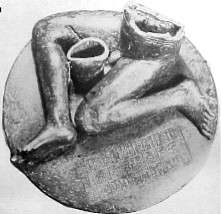Bassetki Statue
 | |
| Material | Copper |
|---|---|
| Size |
diameter: 67 cm (26 in) height: 43 cm (17 in) weight: 150 kg (330 lb) |
| Writing | Old Akkadian cuneiform |
| Created | Akkadian period (2350–2100 BCE) |
| Discovered | Bassetki, Duhok Governorate, Iraq |
| Present location | Iraq Museum, Baghdad |
| Identification | IM77823 |
The Bassetki Statue is a monument from the Akkadian period (2350–2100 BCE)[1] in Mesopotamia that was found in the 1960s near the village of Bassetki in Duhok Governorate, northern Iraq. The statue was cast from pure copper, weighs 150 kilograms (330 lb) and shows a seated, nude human figure on a round pedestal. Only the lower part of the figure is preserved. The pedestal contains an inscription in Akkadian indicating that the statue once stood in the doorway of a palace of the Akkadian ruler Naram-Sin. The statue was looted from the Iraq Museum during the 2003 invasion of Iraq but subsequently retrieved and returned to the museum.
Discovery, theft and recovery
The Bassetki Statue was discovered in the 1960s during construction work on a road between Duhok and Zakho near the town of Bassetki in Duhok Governorate, northern Iraq. The Bassetki Statue was among the many artifacts that were looted from the Iraq Museum during the 2003 invasion of Iraq. During the theft, it had been dropped several times, as could be determined from a trail of cracks in the floor of the museum. It was listed number 2 on a list of the 30 most-wanted antiquities that were stolen from the museum. Its recovery came about after the American 812th Military Police Company raided a house and arrested three people in October 2003. They revealed the location of the Bassetki Statue, which turned out to be coated in axle grease and hidden in a cesspool. It was subsequently fished out and displayed in the Iraq Museum on 11 November, together with over 800 stolen small objects that had also been retrieved.[2][3]
Description
The statue consists of a seated nude, male figure on a round base. The upper body and the head of the figure have not been preserved.[4] It was cast from pure copper using the lost-wax process.[5] The statue's base has a diameter of 67 centimetres (26 in) and is 25 centimetres (9.8 in) high. The preserved part of the figure itself is 18 centimetres (7.1 in) high.[6] The statue weighs 150 kilograms (330 lb).[2] According to several scholars, the statue stands out for its naturalistic rendering of the human body.[2][5] This naturalism was a new development characteristic for the Akkadian period.[4] The Bassetki Statue contains a cuneiform inscription written in Old Akkadian. The inscription deals with the Akkadian ruler Naram-Sin (2254–2218 BCE), grandson and third successor of Sargon of Akkad, the founder of the Akkadian Empire. It recounts that, after Naram-Sin crushed a large-scale revolt against his rule, the inhabitants of the city of Akkad asked the gods to make Naram-Sin the god of their city, and that they built a temple for him in the middle of the city.[5]
See also
Footnotes
- ↑ Dates according to the so-called Middle Chronology.
- 1 2 3 Russell, John M. (2003). "The MPs do it Again: Two more Antiquities from the Top 30 are back in the Iraq Museum" (PDF). Publications and New Media. AIA: 1–3. Retrieved 23 August 2011.
- ↑ Bogdanos, Matthew (2011). "Thieves of Baghdad: The Global Traffic in Stolen Iraqi Antiquities". In Manacorda, S.; Chappell, D. Crime in the Art and Antiquities World: Illegal Trafficking in Cultural Property. New York: Springer. pp. 143–171. doi:10.1007/978-1-4419-7946-9_9. ISBN 978-1-4419-7946-9.
- 1 2 Collins, Paul (2005). "From Village to Empire: The Rise of Sumer and Akkad". In Polk, Milbry; Schuster, Angela M.H. The Looting of the Iraq Museum, Baghdad. New York: Abrams. pp. 82–99. ISBN 0-8109-5872-4.
- 1 2 3 van de Mieroop, M. (2007). A History of the Ancient Near East, ca. 3000-323 BC. Malden: Blackwell. pp. 68–69. ISBN 0-631-22552-8.
- ↑ "Lost Treasures from Iraq--Objects". Iraq Museum Database. Oriental Institute. 2005. Retrieved 23 August 2011.